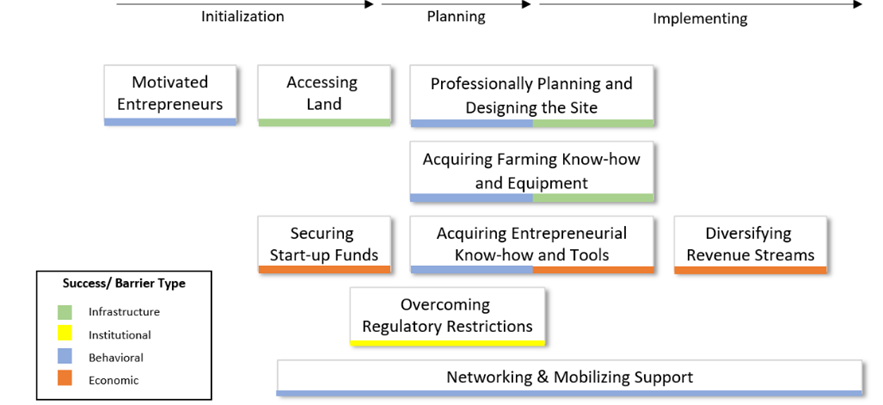Introduction to food forests
Food forests offer a way to grow food aligned with nature. They are designed to use 3-7 plant layers including trees, shrubs and groundcover of mostly perennial, edible plants. The harvest is as diverse as the plants and often includes fruits, nuts, leaves, herbs and mushrooms. Besides food, they offer multiple environmental services including habitat, heat mitigation, healthy soil, improved water cycles and carbon storage. Furthermore, they can be places of recreation, education and community building. Designed and managed appropriately, they can sustain the livelihood of farmers. With these features, food forests address several problems industrial food systems cause (malnutrition, economic disparities, biodiversity loss, climate change, lack of food literacy, etc.). However, despite their obvious benefits, they are rarely known in industrial contexts.

Layers of a food forest in semi-arid Arizona with plant and product examples, and the multiple services it offers
Food Forests vs. Forest Gardens
There is a diversity of food forest systems out there. Most offer educational services, and only few manage to professionally produce food. To distinguish the diversity of systems, we defined a minimum size of 0,5ha for a food forest to offer substantial food production (Albrecht & Wiek 2021). Smaller systems are considered a forest garden. In this guide, we included one site (Arcosanti) that is smaller, and strives for but struggles with a food production focus. Although its founders call it a “food forest”, here it is called a “forest garden”.
The Need for Forest Farmers
Recent food forests in industrial food systems are often organized as multi-functional hybrids and are part of other sustainability-oriented projects. As many food foresters have a socio-cultural background, they mostly focus on education and community building. However, for a shift in our food system, we need more of these biodiverse production systems. Only few sites focus on a sizable food production that goes beyond self-sufficiency. From the database of 200 sites that I created during my PhD [1], around 20 food forests (10%) focus on professional food production. Most of these farmers have a background in agriculture, forestry or agroforestry through university or practical experience.
Often food forests lack the integration of sustainable business knowledge. Only few have been developed as sustainable enterprises with robust business and financing plans due to a lack of experience or interest. Lack of interest is anchored in concerns about the exploitative business practices of conventional enterprises. There is a gap in integrating novel knowledge about social-finance options as well as sustainable business practices and models, including cooperative business and benefit corporation models. Most food foresters therefore struggle to sustain their livelihoods, despite the fact that multi-functional food forests allow for numerous marketable products and services. This lack of economic viability hinders seizing the full potential and advancing the uptake of food forests as sustainable food system solutions.
Sucess Factors & Barriers to Implementation
Since the early 2000s, the number of food forests worldwide is steadily increasing; yet, the overall number is still small, leaving this potent sustainable food system solution largely untapped. This is, in part, due to economic barriers: food forests require overcoming short-term profit orientation and adopting long-term and regenerative, i.e., sustainable business practices and models, which are often less known and lack training opportunities for.
Based on previous research [1], major success factors for food forest implementation are acquiring business and specialty farming know-how, raising sufficient start-up funds for infrastructure and staff, and securing long-term land access.

General development path of food forests with relevant success factors (Albrecht & Wiek 2021b)
To overcome the barriers connected to these milestones, novel funding and land access schemes are needed that support the start-up of sustainability-oriented food forest entrepreneurship that aims at producing food while offering social and environmental services. Such schemes include, e.g., land trusts, cooperative businesses or carbon marketing schemes. Furthermore, the long-term orientation of food forests calls for purposeful economic partnerships that last over long periods of time. All of these success factors interact with and are, to some extent, dependent on a supportive entrepreneurial ecosystem.
This guide will address each of these success factors, give an overview and dive deeper into some aspects encountered at our case studies.
Further readings: Hirstory of Food Forestry, About us
[1] References:
Wiek, A., & Albrecht, S. (2022). “Almost there” – on the importance of a comprehensive entrepreneurial ecosystem for developing sustainable urban food forest enterprises. Urban Agriculture & Regional Food Systems., 7(1). https://doi.org/10.1002/uar2.20025
Albrecht, S., & Wiek, A. (2021a). Food Forests – Their Services and Sustainability. Journal of Agriculture, Food Systems and Community Development, 10(3), 91–105. https://doi.org/10.5304/jafscd.2021.103.014
Albrecht, S., & Wiek, A. (2021b). Implementing Sustainable Food Forests – Extracting Success Factors Through a Cross-Case Comparison // Implementing sustainable food forests: Extracting success factors through a cross-case comparison. Journal of Agriculture, Food Systems and Community Development(11 (1)), 183–200. https://doi.org/10.5304/jafscd.2021.111.019
Albrecht, S., Wiek, A., & Friedel, A. (2022). Transdisciplinary Partnerships for Developing Sustainable Food Forests. Leuphana University Lüneburg. Unpublished Manuscript.